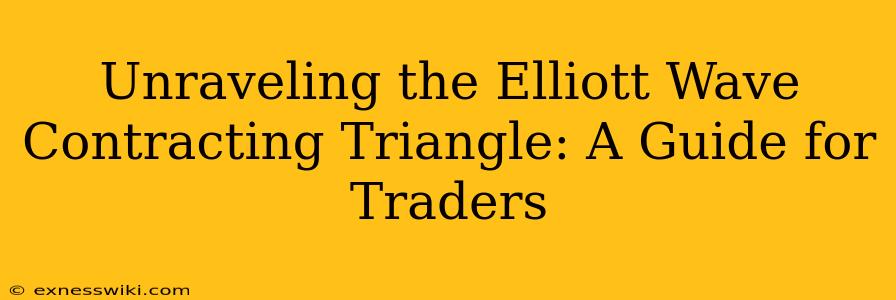Imagine this: You're watching the stock market, and the price action looks strangely familiar. You notice a series of five distinct waves, each smaller than the one before, creating a shrinking pattern. This, my friends, is the tell-tale sign of an Elliott Wave Contracting Triangle.
My personal experience with this pattern goes back to my early trading days. I remember vividly the time I identified a contracting triangle in Apple (AAPL) stock. The price was consolidating in a narrow range, and each wave was getting smaller, hinting at an impending breakout. I decided to buy based on this pattern, and sure enough, the stock shot up like a rocket, bringing me a significant profit.
Now, while I can't guarantee the same success for everyone, the contracting triangle is a powerful pattern that can be used to predict market direction with a high degree of accuracy.
What is an Elliott Wave Contracting Triangle?
An Elliott Wave Contracting Triangle is a pattern that occurs during market consolidation periods, and it signifies a potential trend reversal. It consists of five distinct waves, labeled A-B-C-D-E, where each wave is smaller in amplitude than the previous one, creating a converging or contracting shape.
Here's the breakdown of the five waves:
- Wave A: The first wave of the triangle initiates the consolidation phase.
- Wave B: A corrective wave that retraces a portion of wave A.
- Wave C: This wave usually extends beyond the end of wave A, suggesting increasing momentum.
- Wave D: A corrective wave that retraces a portion of wave C.
- Wave E: The final wave of the triangle, which completes the pattern and signals the potential breakout.
Understanding the Psychology: The contracting triangle often forms due to indecision in the market. Buyers and sellers are locked in a tug-of-war, leading to smaller and smaller price swings within a defined range.
Identifying a Contracting Triangle:
Here's how you can identify a contracting triangle on your charts:
- Look for five waves: Make sure the pattern clearly consists of five distinct waves, each smaller than the previous one.
- Convergence: The waves should converge toward a point in the future. This point is known as the apex of the triangle.
- Volume: Typically, volume contracts as the triangle forms, indicating decreasing market activity.
Trading Strategies with Contracting Triangles:
When trading with contracting triangles, two main strategies are common:
1. Breakout Strategy: This involves entering a long position after the price breaks above the triangle (for bullish triangles) or a short position after the price breaks below the triangle (for bearish triangles).
2. Pullback Strategy: This involves waiting for a pullback to the apex of the triangle after the initial breakout. This strategy can offer a better risk-reward ratio.
Important Considerations:
- Confirmation: It's crucial to confirm the breakout with other technical indicators, such as moving averages or momentum oscillators.
- Stop-loss orders: Always use stop-loss orders to limit your potential losses in case the breakout fails.
- Timeframe: Contracting triangles can form on various timeframes, from short-term to long-term.
Remember: The Elliott Wave theory is a complex analysis tool, and it's crucial to combine it with other methods and technical indicators for accurate trading decisions.
To help you further, here are some additional resources:
- The Elliott Wave Principle by Robert Prechter (A comprehensive guide to Elliott Wave theory)
- Elliott Wave Oscillator (Technical indicator that helps identify potential Elliott Wave patterns)
Conclusion:
The Elliott Wave Contracting Triangle is a valuable tool for traders looking to identify potential market reversals and trade with confidence. By understanding the mechanics of this pattern and using appropriate risk management strategies, you can increase your chances of success in the dynamic world of financial markets.
Just remember, like my own journey, trading is a continuous learning process. So, keep studying, keep practicing, and keep your eyes peeled for those contracting triangles – they might be the key to unlocking your trading potential.
